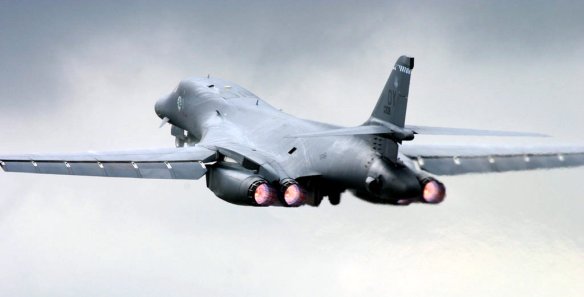“Cockpit layout”
The U.S. Air Force’s B-1 bomber program has been fraught with controversy. The aircraft, which was designed to replace the aging B-52 intercontinental bomber, proved to be overly- sophisticated and trouble-prone in the field. Still, the aircraft emerged in the 2001 U.S. campaign in Afghanistan as a powerful strike bomber. What was the background on the B-1?
In November 1969, the United States Air Force issued a specification for a multi-role, long-range bomber, capable of flying intercontinental missions without refueling. Once near the target, the aircraft was expected to penetrate both contemporary and predicted future enemy air defenses. The aircraft could carry both conventional and nuclear bombs as well as extensive electronic countermeasures (ECM) equipment.
After careful evaluation of proposed designs, in June 1970 the Air Force selected the Rockwell corporation to build the B-1. A contract for five test aircraft was issued and Rockwell went to work. The First aircraft took to the air in December 1974. The new bomber was sleek, fast and sophisticated, perhaps too much so to be viable. The prototype had a swing-wing (variable geometry) design. With wings swept back, it could streak to mach 1.25. With its wings extended, it could maintain stable flight at slower speeds for take-offs and landings. The B-1 was powered by four General Electric 010-GE-102 turbofan engines which allowed the aircraft to take off with a maximum weight of 477,000 lbs. The engines also allowed the aircraft to carry up to 84 x 500 lb bombs or a variety of missiles. On long range missions, the B-1 could obtain an unrefueled flight of 7,455 miles.
These flight and bomb carrying characteristics of the B-1 were impressive. However, the heart of the new bomber was its sophisticated navigation, radar and electronic countermeasures suite. The aircraft could fly “nap of the earth,” closely following terrain in order to avoid enemy radar. The 147 foot long bomber could fly at an altitude of 200 feet at speeds of 600 miles an hour. It could jam enemy radars, confuse enemy radar tracking missiles and penetrate any air defense on the planet.
Unfortunately, flying such low level missions had a downside. The B-1’s advanced electronics failed on occasion and there was no room for error when the slightest miscalculation could plow the aircraft into the ground. The complex jamming arrays of the electronic countermeasures system were so good that it did, on occasion, jam the electronics of the bomber itself! These and other problems led to extensive testing and modifications. Finally, in June 1977, President Jimmy Carter canceled the B-1 program in favor of the cruise missile.
Though the cruise missiles were effective, they could not project the same punch as the B-1 which, could be reused on multiple missions and provide an aerial “show of strength.” Still, proponents of the aircraft knew if they could resurrect the program and incorporate modifications into a new version of it, they might have a winner. In October 1981, President Ronald Reagan authorized the construction of 100 B-1B bombers.
The B-1B, or Lancer as it was now called, had a stronger airframe, better electronics, strengthened landing gear, improved engine design and many other new features. Most important, the B-1B’s electronic jamming equipment was improved. The infrared countermeasures, radar location and warning systems were integrated to complement its low radar cross-section and form a defensive package for the aircraft.
The first B-1B took to the air in October 1985. Much of the development and testing program had been accomplished on the B-1A, and so the test flights proceeded quickly. The aircraft was accepted by the Air Force and the first production model was delivered in July 1985.
The new aircraft was assigned to the nuclear deterrence role until the Gulf War of 1991. Though the aircraft could have been used to attack Iraqi targets in the Gulf, the Air Force decided to retain the aircraft in its primary role and the B-l s remained in the United States on alert to counter any nuclear attack.
The B-1Bs proved expensive to operate. After they entered service, the B-1B fleet never achieved the Air Force’s objective of having a 75-percent mission capable rate. In 1992 and 1993, the B-1B mission capable rate averaged about 57 percent. The Air Force blamed the low rate on the level of funding provided to support the B-1B logistics support system. Concerned about the low mission capable rate, the Air Force decided to reconfigure many of the bombers to carry conventional ordnance. With proper funding and care, the availability of the B-1Bs rose to 84.3%.
The 2001 war in Afghanistan offered the B-1B a new opportunity to demonstrate its capabilities. The original aircraft was designed to carry Mk-82 non-guided 500 lb gravity bombs. Improvements in the aircraft’s bomb bays and delivery systems allowed it to deliver up to 30 Cluster Bomb Units (CBUs) per sortie for enhanced conventional attacks. Another upgrade consisted of a modification for the bomb module from the original configuration of 28 x 500-pound bombs to 10 x 1,000- pound cluster bombs per bomb rack. The B-1B can also carry the JDAM and the Wind Corrected Munitions Dispenser (WCMD), Joint Standoff Weapon (JSOW) and Joint Air to Surface Standoff Missile (JASSM) for standoff capability.
The B-1B has already flown many bombing missions over Afghanistan and Iraq; with its powerful bomb load and ability to fly “nap of the earth” missions with little fear of being downed, the Lancer will undoubtedly prove its worth in any war.
